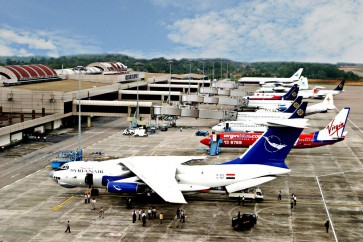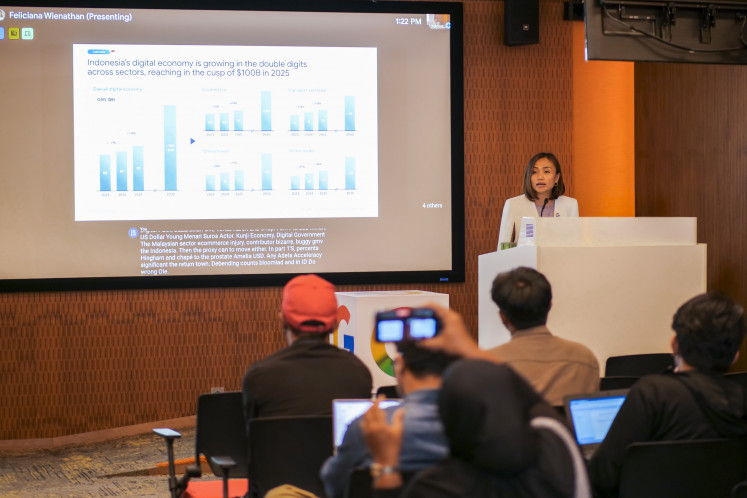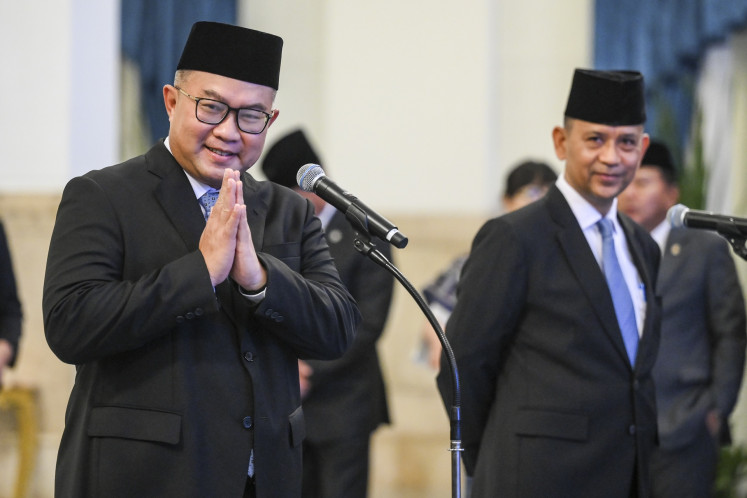Popular Reads
Top Results
Can't find what you're looking for?
View all search resultsPopular Reads
Top Results
Can't find what you're looking for?
View all search resultsI Wayan Sadra: Not an ordinary musician
Born in Denpasar, Bali, I Wayan Sadra built his career in Surakarta, Central Java
Change text size
Gift Premium Articles
to Anyone
B
orn in Denpasar, Bali, I Wayan Sadra built his career in Surakarta, Central Java. Sadra is a contemporary musician with various forms of music, including an ensemble and meditative music.
JP/Ganug Nugroho Adi
His music is beyond the “order” so that it is not often called ordinary music. The label “Not Ordinary Music” was later used by Sadra to name his program, held every two months at the Art House of Surakarta Cultural Park (TBS) in Surakarta or Solo.
“This program is not to show off. Not Ordinary Music is [held] to provide room for those who are interested in exploring music,” Sadra said on the verandah of the Art House.
Not Ordinary Music is a forum designed for musicians who want to present their works that don’t fit into the category of mainstream music. Musicians are free to present their creative music. Some of them use paint cans, mineral water bottles and coins to produce sounds, some combine gamelan with piano. No problem. A free discussion is held after the concert.
“Regardless of the form, I always base my work on local music, especially gamelan. This can’t change,” said the musician who was a curator of the Solo International Ethnic Music in 2007.
Sadra learned to play gamelan when he was a child. In his home kampong, Kaja, almost all of his neighbors were gamelan players.
Upon his graduation from junior high school, he went to the Bali Traditional Music Conservatorium.
Sadra left Bali after he met choreographer Sardono W. Kusuma in 1974. That was when he performed his work as an illustration for Dongeng dari Dirah (Dirah’s Tale), a dance drama created by Sardono. In the same year, along with Sardono and choreographer Hajar Satoto, he performed the dance drama around Europe for four months.
“Mas Don [Sardono W. Kusumo] made me think outside the square. I used to think that traditional Balinese music was the most perfect. He opened my mind,” said Sadra, who was born on Aug. 1, 1954.
Like Sardono, music critic Suka Hardjana was also impressed by Sadra’s music. He gave him an opportunity to perform at the Young Composers’ Week II 1980 at the Taman Ismail Marzuki Art Center in Jakarta. The spectators were surprised. At that time, he created a composition from the sound of rotten eggs dropping on stone.
His concert triggered a debate among music critics. But an artist who was also head of the Indonesian Traditional Music Academy (ASKI) in the town, S.D. Humardani known as Gendon Humadani, categorized Sadra’s music as installation art, which was developing in America.
“Pak Gendon then asked me to teach at ASKI. I took his offer two yeas later,” said Sadra, who studied at the Jakarta Arts Institute (LPKJ, now IKJ) in 1975 for three semesters.
In 1979, Sadra established Sonoseni Ensemble, a music group which, according to Sadra, had more emphasis on instrument exploration, not fully depending on mainstream (pop) music.
For most people, Sadra’s music might sound weird. But Sadra keeps going. In 2009, he again made a surprise by bringing a cow on to the stage (Borderless, Salihara Community, Jakarta). Long before that, in 1995, Sadra used bakiakor teklek (wooden sandals) to play his music in a composition titled Mulutmu Tong Sampah (Your Mouth is a Garbage Container). Through this performance, Sadra wants to emphasize that you can play and compose music with every day items.
“They call it unpopular music. Music which largely cannot be understood,” said the winner of New Horizon Award in 1991 from the International Society for Arts, Sciences and Technology, Berkeley, California, USA.
He is the first Asian to receive the prestigious award in music. He was considered a miles stone of the world contemporary music.
Indonesia, according to Sadra, has the richer music tradition than other countries. But its music becomes poor because only a handful of musicians dare to present traditional music. He cited as an example The Coors from Ireland, which plays traditional music with Celtic nuance.
“We have gamelan. If we want to be part of the world music, gamelan is one of our capitals.
Unfortunately, many of our musicians even imitate the music style of other people,”
said the musician who is taking his doctoral study in music at the Indonesian Institute of the Arts (ISI) Yogyakarta.
But he understood the tendency because most of musicians today make their music merely for commercial aspect. New singers and band group come and go. They play one or two singles for mobile ring back tone and then they are replaced by other new comers.
“They have the fast food music concept, instant, because the market allows them to do so. Our music is directed by the industry to follow the market’s taste. The singers and the band may be different, but they produce the same music,” said Sadra, who will perform with his Sonoseni Ensemble in New Zealand in October.
Now, amid his activities as a lecturer at the ISI Surakarta, Sadra keeps experimenting through the Not Ordinary Music program. He is also preparing several tours in Asia and Europe for the Sonoseni Ensemble.
He is an Indonesian musician who has collaborated with foreign musicians from various countries such as South Africa, Spain, Germany, New Zealand, the United States and Japan.










